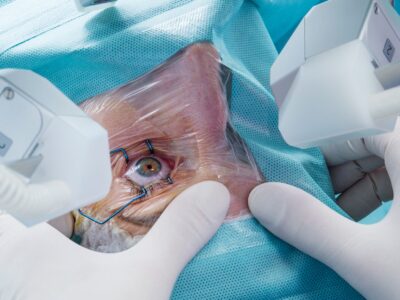
Signs, Types, and other Facts about Cataracts Surgery
May 20 2023 Cataract Eye Surgery cataract eye surgery cataract surgery cataract surgery sydney cataracts surgeryCataract surgery is the surest treatment for cataracts which gives you a cloudy lens of your eye. The cataract is a clump of proteins that can cause a patient’s vision problems, which could also worsen over time. Research even shows that cataracts are the commonest cause of blindness worldwide. However, cataracts surgery is one of the safest surgical procedures without severe complications.
The lens of your eye with the pupil and the iris help to focus on objects at different distances. But when a cataract affects the eye, it compromises this vision’s quality, thereby giving it a dull vision. The cataracts surgery process corrects this by replacing the cloudy lens with an artificial lens implant. The process may require an ultrasound probe, a laser for incision, or a manual method.
What is Cataracts Surgery?
Cataracts surgery is targeted at cataracts in the eye lens as one of the world’s safest and most common eye surgeries. It also has a success rate of over 95%. It got a restored vision in no time. The process allows the eye surgeon to replace your natural lens with an artificial lens capsule. It first destroys the proteins on the natural lens and sucks it out before a lens implant.

Signs that you need cataract surgery
A cataract is more common in older people as age advances; it may also worsen. In addition, an underlying disease may also enhance the risk of developing cataracts. Eventually, the patient will need cataract surgery to solve the problem. However, in the early stages, the changes in the lens effectiveness may not be significant enough to cause vision impairment.
Therefore, at the early stage, the patient may not need surgery until the latter stages, when the cataract has accumulated. As a result, the eye doctor would only recommend cataract surgery when the cataracts are becoming noticeable and affecting the patient’s vision.
You need cataract surgery if you experience difficulty driving, reading, and looking at bright lights. In addition, if you notice some whitish substance on your lens, it may indicate that you have cataracts. Some other specific ways cataracts may affect your vision include the following.
- Blurry vision
- Faded color vision
- Impaired night vision
- Halos around lights when you see them
- Double vision when you look at an object
- Hypersensitivity to bright and glare light pass
Another important cause of cataracts that is worth mentioning is the genetic link. A baby can inherit a cataract from a mother and have it at birth. As a result, congenital cataracts occur in children, causing blindness. However, the child can also undergo cataract surgery before reaching 6 weeks. Cataract surgery is the safest and easiest surgical procedure.

Types of Cataract Surgery
Cataract surgery involves replacing a cloudy natural lens with a new artificial lens, usually an intraocular lens (IOL). Below are some of the most typical types of cataract surgery.
Phacoemulsification (Phaco) Cataract Surgery
During Phaco, a small incision cataract surgery (SICS) procedure, the eye surgeon makes a tiny incision between 2 and 3mm. Then an ultrasonic probe is passed through the incision to break up cataracts with vibration. Afterward, the doctor sucks up the fragments by suction and inserts a foldable lens through them. Whatever small wound is left behind can heal naturally without any aid.
Manual extracapsular cataract surgery (MECS)
When a patient enrolls for MECS, the surgeon makes a bigger incision on the lens, about 9 to 13 mm long. He then removes the natural lens and uses a replacement lens capsule instead. However, this technique has a higher risk of complications because of the relatively bigger incision on the lens. Nevertheless, people may still prefer this method because of its low cost.
Manual small incision cataract surgery (MSICS)
MSICS is similar to MECS in the technique, but it involves a v-shaped incision. This incision reduces the outer space of the eye but gives a broader inside. Consequently, the outer incision measures about 6.5 to 7mm, while the internal incision measures about 11mm. Both procedures have long-term benefits and risks or complications. The short-term results also occur in 3 months in phaco, but MSIC is far cheaper than the former.
Femto Laser-assisted Cataract Surgery (FLACS)
Instead of making an incision with a manual tool, the eye surgeon can also make an incision with a laser beam. That procedure is known as FLACS. Using a laser beam can break up and often the cataract without needing the energy that phacoemulsification requires. It can also enhance the rapid healing of the eyes.

Using a laser can also lead to a more accurate incision that can correct astigmatism. In that case, the FLACS procedure corrects other eye diseases. In the case of astigmatism, the front of the eye has an irregular shape that leads to poor vision. As a result, the patient finds it hard to function without glasses. But it is an expensive technique out of all.
Intracapsular Cataract surgery
Another type of cataract surgery is intracapsular cataract surgery, an older process of dealing with cataracts by removing the entire lens. It also removes the lens capsule from your eye by boring a large incision. However, today this method is not often used due to many complications.
Lens Options for Cataract surgery
There are several options to consider when it comes to the lens implant of an artificial lens for your natural lens. The choice of lens you make can be determined by the lifestyle you have or the price range you can afford. Below are the choices of the lens in the market. Whichever lens you choose, the eye doctor will require you to apply eye drops after the surgery.
Monofocal lens
The most common type of lens is the mono-focal lens which is usually part of your health insurance. However, your insurance partner may require a premium to cover other lenses. Note that the mono-focal lenses take care of your vision to be the best at a certain distance. In other words, mono-focal lenses are for single-distance vision where the patient can now use them to read without glasses.
The other lens types include
- Toric lenses are specifically designed to correct astigmatism.
- Extended depth of focus
- Accommodating mono-focal lenses
- Multifocal lenses
Conclusion
The cataract forms on the clouded lens restrict having normal vision with the posterior capsule opacification. Therefore, cloudy vision requires a clear artificial lens as a replacement lens. Cataract surgery is the sure way to restore perfect vision.



